
Guests
- Jack Shaheenaward-winning media critic and author of Reel Bad Arabs: How Hollywood Vilifies a People. He is also professor emeritus of mass communications at Southern Illinois University and was a former consultant on Middle East affairs for CBS.
Where are the human images of Arabs and Arab Americans? That’s the topic of a new film called “Reel Bad Arabs: How Hollywood Vilifies a People.” The book and the film explore the American cinematic landscape to reveal a stark pattern of Arab stereotyping and its disturbing similarity to anti-Semitic and other racist caricatures through history. We play excerpts of the film and speak to acclaimed media critic Jack Shaheen, author of the book it’s based on. [includes rush transcript]
Transcript
AMY GOODMAN: We’re going to turn right now to the images, the human images, of Arabs and Arab Americans. Where are they? That’s the topic of a new film called Reel Bad Arabs: How Hollywood Vilifies a People. It’s based on a book by the same name by acclaimed media critic Jack Shaheen. Both the book and the film explore the American cinematic landscape to reveal a stark pattern of Arab stereotyping and its disturbing similarity to anti-Semitic and other racist caricatures through history.
In a little while, we’ll be joined by Jack Shaheen, but first I want to play some excerpts of the film version of his book. It’s directed by Sut Jhally. The New York premiere happened this week at the Cinema East Film Festival on Thursday.
JACK SHAHEEN: For years, I have looked at how we — particularly, when I say “we,” image makers — have projected Arabs on silver screens. In my latest book, Reel Bad Arabs: How Hollywood Vilifies a People, I looked at more than 1,000 films, films ranging from the earliest, most obscure days of Hollywood to today’s biggest blockbusters. And what I tried to do is to make visible what too many of us seem not to see: a dangerously consistent pattern of hateful Arab stereotypes, stereotypes that rob an entire people of their humanity.
All aspects of our culture project the Arab as villain. That is a given. There is no deviation. We have taken a few structured images and repeated them over and over again. Whether one lives in Paduka, Kentucky or Wood River, Illinois, we know basically the same thing. We know the mythology — the mythology, namely Hollywood’s images of Arabs.
We inherited the Arab image primarily from Europeans. In the early days, you know, maybe 150 years, 200 years ago, the British and the French who traveled to the Middle East, and those who didn’t travel to the Middle East, conjured up these images of the Arab as the Oriental other. The travel writers, the artists, who fabricated these images and who were very successful, as a matter of fact — and these images were transmitted and inherited by us. We took them, we embellished them, and here they are.
PRINCESS SHALIMAR: [clip from Harum Scarum When you cross the mountains of the moon into our country, Mr. Tyronne, you will be stepping back 2,000 years.
JACK SHAHEEN: We have this fictional setting called “Arabland,” a mythical theme park. And in Arabland, you know, you have the ominous music, you have the desert. We start with the desert, always the desert, as a threatening place. We add an oasis, palm trees, a palace that has a torture chamber in the basement. The pasha sits there on his, you know, posh cushions with harem maidens surrounding him. None of the harem maidens please him, so they abduct the blonde heroine from the West, who doesn’t want to be seduced.
When we visit Arabland, you must be aware of the instant Ali Baba kit. What we have, we have the property masters of Hollywood going around, and they’re cladding the women in see-through pantaloons, belly dancing outfits. They’re giving the Arab villains scimitars, you know, these, long, long scimitars. We see people riding around on magic carpets, turbaned charmers programming snakes in and out of baskets.
Yesteryear’s Arabland is today’s Arabland.
GRAND VIZIER JAFAR: [clip from Aladdin You are late.
GAZEEM: A thousand apologies, o patient one.
GRAND VIZIER JAFAR: You have it, then?
GAZEEM: I had to slit a few throats, but I got it.
JACK SHAHEEN: Disney’s Aladdin was seen by millions of children worldwide. It was hailed as one of Disney’s finest accomplishments, but the film recycled every old degrading stereotype from Hollywood’s silent black-and-white past.
ALADDIN OPENING MUSIC: Oh, I come from a land, from a faraway place, where the caravan camels grow, where they cut off your ear if they don’t like your face. It’s barbaric, but, hey, it’s home.
JACK SHAHEEN: “Where they cut off your ear if they don’t like your face. It’s barbaric, but, hey, it’s home.” Now, how could a producer with a modicum of intelligence, just a modicum of sensitivity, let a song such as that open the film? 300 movies, nearly 25 percent of all Hollywood movies that, in one way or another, demean Arabs, contain gratuitous slurs, or they portray Arabs as being the butt of a cheap joke.
UNIDENTIFIED: [clip from The Bonfire of the Vanities We were going into Mecca, see? And the plane is full of Arabs with these animals — goats, sheep, chickens. I mean, they don’t go anywhere without their goddamn animals. We had to put plastic in the cabins. You know, they urinate, they defecate.
JACK SHAHEEN: You have films by Neil Simon like Chapter Two.” The beginning of the film, the protagonist arrives back from London, and his brother says, “How was London?” And he says, “Full of Arabs.”
LEO SCHNEIDER: [clip from Chapter Two How was London?
GEORGE SCHNEIDER: Full of Arabs.
JACK SHAHEEN: Wow! Imagine if he had said, “Full of blacks,” “Full of Jews,” “Full of Hispanics.” I mean, that’s ridiculous. Why do we do these things?
One of the most offensive films, with the gratuitous images, Father of the Bride 2. It features Steve Martin selling his house to a Mr. Habib.
MR. HABIB: [clip from Father of the Bride 2 We like house very much. When you can move out?
GEORGE BANKS: Excuse me?
REALTOR: The Habibs would like to buy the house, George. It’s exactly what they’ve been looking for.
MR. HABIB: Yes. When you can move? We need house a week from Wednesday. And my wife wants flower dishes in kitchen. You sell? We pay top dollar.
JACK SHAHEEN: When Habib’s submissive wife tries to speak, he shouts gibberish at her. And then he offers Martin a $15,000 cash bonus to move out in 10 days. When Martin tells Mr. Habib that he doesn’t want to sell the house after all, he finds Habib’s wrecking crew there, ready to demolish his beautiful home. And in a scene that calls to mind one of the most degrading stereotypes of the Jewish people, Mr. Habib demands an extra $100,000 to sell the house that he has owned for just a day back to Martin.
GEORGE BANKS: [clip from Father of the Bride 2 You want me to take out a loan on something I owned free and clear just 24 hours ago?
MR. HABIB: Well, that is up to you, George. Your park, your fence, your memories.
JACK SHAHEEN: Now, if you looked at the other Father of the Bride films — Elizabeth Taylor, Spencer Tracy — there were no Arabs or Arab Americans. So why does Disney inject these horrific sort of offensive characters in Father of the Bride, Part 2? It’s the same reason that in Gladiator the slave traders who kidnap Russell Crowe and bring him back to Rome are Arabs. I mean, this is ridiculous. I mean, why does Hollywood inject Arabs, scenes of Arabs and/or slurs demeaning Arabs in movies having nothing to do with the Middle East?
So, you’re sitting like I am, for example, watching Back to the Future, about a mad scientist. And yet, early on in the film, we see these ugly inept Libyans with machine guns in a parking lot trying to gun down the protagonist. I mean, why? This movie wasn’t about the future. It was the same old stereotyping from the past.
And the same goes for Hollywood’s view of Arab women. The Arab woman today is bright, intelligent. She’s someone who is succeeding in all professions, and yet this reality still is being denied us on silver screens. The highly sexualized belly dancer has been with us from the beginning of Hollywood’s history, inspired by early images of the Orient as the place of exoticism, intrigue and passion. But in recent years, this image has dramatically changed. The Arab woman is now projected as a bomber, a terrorist. Added to this image is what I call “bundles in black,” veiled women in the background, in the shadows, submissive. It seems the more Arab women advance, the more Hollywood keeps them locked in the past.
Politics and Hollywood’s images are linked. They reinforce one another. Policy enforces mythical images; mythical images help enforce policy. Jack Valenti, president of the Motion Picture Association of America, has said, quote, “Washington and Hollywood spring from the same DNA,” end-quote.
The Arab image began to change immediately after World War II. There were three things that impacted the change: the Palestinian-Israeli conflict, in which the United States has unequivocally supported Israel; the Arab oil embargo in the ’70s, which angered Americans when gas prices went through the ceiling; and the Iranian Revolution, which increased Arab-American tensions when Iranian students took American diplomats hostage for more than a year. These three pivotal events brought the Middle East into the living rooms of Americans and together helped shape the way movies stereotyped Arabs and the Arab world.
One of the primary changes: the image of the sheikh. In a movie such as Rollover, he’s out to take over the world with his money, or he’s up to no good trying to buy chunks of America.
SHEIKH: [clip from Rollover Mrs. Winters, I think I should tell you, there are those in the family who do not think we should be making this offer at all. I assume if you could have found venture capital of this sort for a company like Winter Chem in America, you would not be coming all the way to Arabia looking for it.
JACK SHAHEEN: You see the oily sheikh in Spielberg’s Indiana Jones and the Last Crusade. You see the money-grubbing sheikh who’s out to commit all kinds of terrorism and launch a missile in Ernest in the Army.
SHEIKH: [clip from Ernest in the Army Gentlemen, behold my special club, the pluton missile. With it, I will bring the infidels to their knees and be leader in the Arab world.
JACK SHAHEEN: One of the myths in the ’70s was that the Arabs are coming over, buying up chunks of America. And, of course, this was reflected in the cinema
HOWARD BEALE: [clip from Network That is not the case. The Arabs have taken billions of dollars out of this country, and now they must put it back!
JACK SHAHEEN: One of my favorite movies of all time, racist though it may be, is Network, about commercial television.
TV ANNOUNCER: [clip from Network Ladies and gentlemen, let’s hear it! How do you feel?
AUDIENCE: We’re mad as hell, and we’re not going to take it anymore!
JACK SHAHEEN: Network features a TV anchor rising to super stardom. How? He unleashes wild rants against the system on the air. But he directs the angriest of all his rants at Arabs, who he says are buying up America.
HOWARD BEALE: [clip from Network They’re buying it for the Saudi Arabian investment corporation! They’re buying it for the Arabs!
JACK SHAHEEN: The anchor, Howard Beale, calls on the American people to rise up and stop the Arab buyout of his TV network.
HOWARD BEALE: [clip from Network Listen to me, God damn it! The Arabs are simply buying us! There’s only one thing that can stop them! You!
JACK SHAHEEN: The rage of Americans in response became one of the most famous scenes in movie history.
HOWARD BEALE: [clip from Network I want you to get up now. I want you to get up out of your chairs! I want you to get up right now and write a telegram to President Ford saying, “I’m as mad as hell, and I’m not going to take this anymore!”
RANDOM PEOPLE: I’m mad as hell, and I’m not going to take it anymore! I’m mad as hell, I’m not going to take it anymore! I’m mad as hell, and I’m not going to take it anymore! I’m not going to take it anymore! I’m mad as hell, and I’m not going to take it anymore!
JACK SHAHEEN: This kind of anger, the anger born of fear, all of it in response to a perceived conspiracy and threat by a specific group of people, well, we’ve seen and heard this before. If we look at the anti-Semitic propaganda of the Nazis, at its core is an identical type of economic threat. This economic myth even made its way into children’s books. Sadly, the popular image of Jews in Nazi propaganda resembles the popular image of Arabs in some of our most beloved Hollywood movies, the only difference being that the Arab usually wears a robe and headdress.
To solidify Washington’s connection with Hollywood, simply look at the films produced in cooperation with the Department of Defense, showing our men and women in the Armed Forces killing Arabs at random. Like Iron Eagle, where a teenager goes over and bombs up an Arab country, you know, just learns how to fly a jet overnight. And then, of course, Navy Seals, where Charlie Sheen goes over to Lebanon and obliterates scores of Arabs.
LT. DALE HAWKINS: [clip from Navy Seals Alright, chief, let’s go tag ’em and bag ’em.
JACK SHAHEEN: Of all the Department of Defense films, the one that will stand the test of time as being the most racist is Rules of Engagement. The film was written by former Secretary of the Navy James Webb. The action takes place in Yemen, a real country in the Middle East. There are violent demonstrations at the American embassy, and the Marines, led by Samuel L. Jackson, they’re called in to evacuate the American employees. And as they try to do so, the marines open fire on the crowd and kill scores of Yemeni, including women and children. And in the investigation that follows, Tommy Lee Jones, the lawyer who represents the Samuel L. Jackson character, goes to Yemen to investigate. The movie leads us to believe what seems obvious, that the marines committed this atrocity.
TRANSLATOR: [clip from Rules of Engagement Armed American marines, they were shooting at his people. They were just trying to defend themselves.
JACK SHAHEEN: During his investigation, Jones’s character sees a little girl with only one leg. He follows her, comes upon a hospital ward full of civilian victims. He finds an audiotape by the bed of one of the victims. And when the tape gets translated in court, we immediately begin changing our minds about who is responsible for this massacre.
INTERPRETED TAPE: [clip from Rules of Engagement To kill Americans and their allies, both civil and military, is duty of every Muslim who is everywhere.
JACK SHAHEEN: We discover that the Yemeni civilians aren’t so innocent after all. It turns out they fired on the marines first. And in a moment that will live in Hollywood infamy, we suddenly learn that the little girl we’ve been sympathizing with, the very girl whose humanity and innocence may have broken down our stereotypes, well, she’s no better than those other Yemeni terrorists. As a result, when Samuel L. Jackson delivers the key line —
COL. TERRY L. CHILDERS: [clip from Rules of Engagement Waste the motherf*****s!
JACK SHAHEEN: — we’re now on his side. Why does this matter? Because in the end, the massacre of even women and children has been justified and applauded. It’s a slaughter, yes, but it’s a righteous slaughter.
COL. TERRY L. CHILDERS: [clip from Rules of Engagement Cadre Mack.
CADRE MACK: Sir?
COL. TERRY L. CHILDERS: Contact all stations. Mission complete.
JACK SHAHEEN: The humanity is not there. And if we cannot see the Arab humanity, what’s left? If we feel nothing, if we feel that Arabs are not like us or not like anyone else, then let’s kill them all. Then they deserve to die, right? Islamophobia now is a part of our psyche. Words such as “Arab” and “Muslim” are perceived as threatening words. And if the words are threatening, what about the images that we see in the cinema and on our television screens?
We are at war with Iraq. We went to war in March of 2003. But didn’t our entrance to the war, wasn’t that made a lot easier primarily because for more than a century we had been vilifying all things Arab?
And now, given what happened with 9/11, the tragic events that took place on that day, where 19 Arab Muslim terrorists were responsible for the deaths of nearly 3,000 people, now, instead of saying that’s the lunatic fringe, we say no, no, no, no, the actions reflect the actions of 1.3 billion people. Now, that’s dangerous. We don’t say that the actions of Ku Klux Klan members, who are Christians, represent Christianity, do we?
Look at Oklahoma City, Timothy McVeigh, a good Irish Catholic boy — do we say all Irish Catholics are terrorists? I mean, no one knew McVeigh’s religious beliefs, where he went to church, or his ethnic background. It was not part of the story. Yet, of course, had that been an American with Arab roots or an American Muslim, it would have been a part of the story. Remember that when news of the bombing broke, reporters and politicians, nearly everybody, rushed to judgment without any proof whatsoever.
CONNIE CHUNG: A U.S. government source told CBS News that it has Middle East terrorism written all over it.
CBS REPORTER: The attack in Oklahoma City appears to have a familiar mark.
GOVERNMENT SOURCE: This was done with the attempt to inflict as many casualties as possible. That is a Middle Eastern trait.
ABC NEWS: The fact that it was such a powerful bomb in Oklahoma City immediately drew investigators to consider deadly parallels that all have roots in the Middle East. ABC News has learned that the FBI has asked the U.S. military to provide up to 10 Arabic speakers to help in the investigation.
JACK SHAHEEN: The stereotype has become so widespread that it’s become invisible to people. And the reason being is that we’ve all grown up with these images. Just look at television. We now have TV shows telling us that in addition to the Arab terrorists over there, American Arabs over here are also terrorists.
Then there’s Showtime’s Sleeper Cell. Here, a sinister network of Islamic groups operates on American street corners. Any homeless man could be part of this network. Even Western-looking Arabs are part of this anti-American conspiracy.
WESTERN-LOOKING ARAB: [clip from Sleeper Cell We’re at war with America, period. And we’re going to win that war by convincing enough Americans, through the spread of fear, insecurity and terror, to change their ways. The best way to teach that lesson is by attacking them where they live, work and play.
JACK SHAHEEN: And this paranoia runs deep. Just take a moment and flip through some of our most popular religious channels.
NARRATION: Islam, a religion of two billion members that’s growing by 50 million people annually. Nearly every major terrorist network in the world is led by Islamic fundamentalists.
TELEVANGELIST: Islam is, as we have seen, a religion that teaches the violent subjugation of all non-Muslims. It promises paradise to terrorists and makes the vilest deed a thing of beauty in the eyes of Allah.
JACK SHAHEEN: So, when innocent Arabs are killed, when they’re bombed, maimed, wounded, when they’re tortured in places like Abu Ghraib, is it really any surprise that we don’t feel any compassion or, worse, make light of it?
RUSH LIMBAUGH: This is no different than what happens at the Skull and Bones initiation, and we’re going to ruin people’s lives over it, and we’re going to hamper our military effort. You ever heard of emotional release? You ever heard of need to blow some steam off?
Well, yeah, sort of like hazing, a fraternity prank, sort of like that kind of fun, but the point is, you know, everybody’s been saying that this came from the top…
JACK SHAHEEN: We don’t care about them. We’ve been preconditioned to think that those innocent civilians, clones of al-Qaeda and Saddam Hussein, are one and the same and do not merit our sympathy, our understanding.
AMY GOODMAN: An excerpt of Reel Bad Arabs: How Hollywood Vilifies a People, featuring Jack Shaheen, the award-winning media critic who wrote a book by the same title. In this last few minutes, he joins us live in our firehouse studio. That film has just premiered in New York.
Jack, the significance of the media?
JACK SHAHEEN: Well, as Goebbels said, if you take the same images and you repeat them over and over again, and the images teach us to hate a people and to hate their religion, what happens is that we, in spite of our intelligence, our innate goodness, actually turn around and let these images despise and vilify an entire people.
You just had a guest, a young Iraqi girl that lost both her legs as a result of a bombing in Iraq. If you look at Rules of Engagement, one of the films that I talk about in the book and in the movie, you see a Yemeni girl with one leg on a crutch, who lost her leg when the Marines shot her. But in the end, this little Yemeni girl is not a victim, but a terrorist. So we cannot empathize with this girl who walks around with a crutch.
If you go and you see the new film called The Kingdom, Arab children again are portrayed as terrorists. So what’s happening now is the trend has taken us to a point where we look at all those people, namely Arabs and Muslims, as the enemy other, even children. So when a young Iraqi girl loses both her legs, so there’s a victim that takes place over in the Middle East that we don’t see, we don’t see the suffering, we don’t see the injury. And then, even if we do, our hearts do not reach out for that victim, primarily because we’ve been taught by the media that those children are not to be trusted.
AMY GOODMAN: Jack, do you hold out any hope — we didn’t get to the part of the film where you talk about images that you think are getting better. Overall, would you say it’s worse or better?
JACK SHAHEEN: Well, I think it’s gotten much worse. And it’s gotten much worse, if you look at the film called The Kingdom, where Arabs drop like Cupie dolls in an amusement park. I have hope —
AMY GOODMAN: By the way, the film by James Webb, or by the same Rules of Engagement James Webb. Jim Webb is the senator from Virginia.
JACK SHAHEEN: I know. I know. He wrote the story on which that film was based, and Arnold Schwarzenegger, who’s featured in the documentary, the governor of California, we see him gunning down Palestinians in True Lies. So, the link between politics and entertainment is there. I mean, media enforces policy; policy enforces media. They sort of scratch each other’s back. I mean, it’s a mutual sort of vilification society.
AMY GOODMAN: Well, we have to leave it there, but I look forward to your next book coming out in the next month called Guilty. Thank you for joining us.
JACK SHAHEEN: Thank you, Amy.
AMY GOODMAN: Jack Shaheen, award-winning media critic, his book is Reel Bad Arabs: How Hollywood Vilifies a People. The book is the same title as the film that has just premiered in New York.

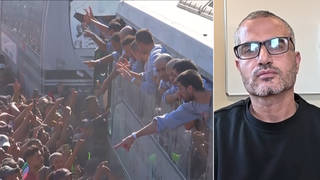
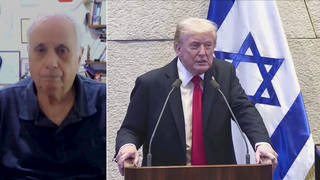
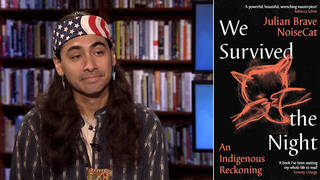
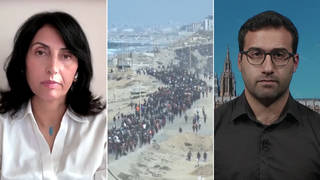


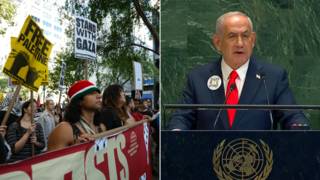


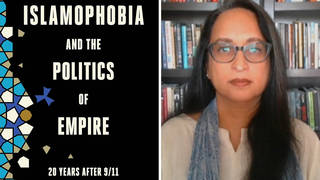

Media Options